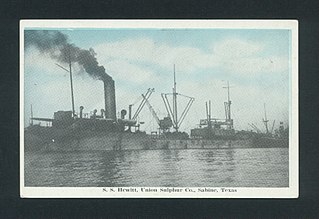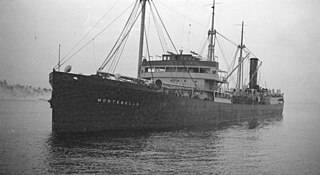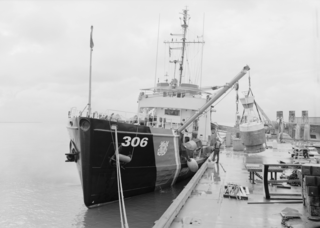Related Research Articles

USS Big Horn (AO-45/IX-207) was a Q-ship of the United States Navy named for the Bighorn River of Wyoming and Montana.

USCGC Mesquite (WAGL/WLB-305) was the lead ship in the Mesquite class of seagoing buoy tenders operated by the United States Coast Guard. She served in the Pacific during World War II, and spent the rest of her Coast Guard career in the Great Lakes. She ran aground and was wrecked in December 1989 off the Keweenaw Peninsula in Lake Superior. She was scuttled nearby as a recreational diving attraction.
F/VAndrea Gail was a commercial fishing vessel that was lost at sea with all hands during the Perfect Storm of 1991. The vessel and her six-man crew had been fishing the North Atlantic Ocean out of Gloucester, Massachusetts. Her last reported position was 180 mi (290 km) northeast of Sable Island on October 28, 1991. The story of Andrea Gail and her crew was the basis of the 1997 book The Perfect Storm by Sebastian Junger, and a 2000 film adaptation of the same name.

The T2 tanker, or T2, was a class of oil tanker constructed and produced in large quantities in the United States during World War II. Only the T3 tankers were larger "navy oilers" of the period. Some 533 T2s were built between 1940 and the end of 1945. They were used to transport fuel oil, diesel fuel, gasoline and sometimes black oil-crude oil. Post war many T2s remained in use; like other hastily built World War II ships pressed into peacetime service, there were safety concerns. As was found during the war, the United States Coast Guard Marine Board of Investigation in 1952 stated that in cold weather the ships were prone to metal fatigue cracking, so were "belted" with steel straps. This occurred after two T2s, Pendleton and Fort Mercer, split in two off Cape Cod within hours of each other. Pendleton's sinking is memorialized in The Finest Hours. Engineering inquiries into the problem suggested the cause was poor welding techniques. It was found the steel was not well suited for the new wartime welding construction. The high sulfur content made the steel brittle and prone to metal fatigue at lower temperatures.

The USCGC Acacia (WAGL-406/WLB-406) is an Iris-class 180-foot seagoing buoy tender operated by the United States Coast Guard. Acacia was a multi-purpose vessel, nominally a buoy tender, but with equipment and capabilities for ice breaking, search and rescue, fire fighting, logistics, oil spill response, and other tasks as well. She spent almost all of her 62-year Coast Guard career on the Great Lakes. After decommissioning she became a museum ship in Manistee, Michigan.

Hammac was a steam tank ship built in 1920–1921 by Bethlehem Shipbuilding Corporation of Alameda for the United States Shipping Board as part of the wartime shipbuilding program of the Emergency Fleet Corporation (EFC) to restore the nation's Merchant Marine. Early in 1923 the vessel together with two other tankers was sold to General Petroleum Corporation and renamed Emidio. The tanker spent the vast majority of her career carrying oil along the West Coast of the United States as well as between West and East coast. In December 1941 she was shelled and damaged by the Japanese submarine I-17 and eventually wrecked with a loss of five crew.

The SS Hewitt was a steel hulled bulk freighter built for the J. S. Emery Steamship Co. of Boston, Massachusetts, as the Pacific. She was sold to the Union Sulphur Company in 1915 and in 1921 she and her entire crew disappeared without a trace off the southeast coast of the United States.

The Battle of the Caribbean refers to a naval campaign waged during World War II that was part of the Battle of the Atlantic, from 1941 to 1945. German U-boats and Italian submarines attempted to disrupt the Allied supply of oil and other material. They sank shipping in the Caribbean Sea and the Gulf of Mexico and attacked coastal targets in the Antilles. Improved Allied anti-submarine warfare eventually drove the Axis submarines out of the Caribbean region.

USS Unimak (AVP-31) was a United States Navy Barnegat-class small seaplane tender in commission from 1943 to 1946 that saw service in World War II. After the war, she was in commission in the United States Coast Guard as the cutter USCGC Unimak (WAVP-379), later WHEC-379, WTR-379, and again WHEC-379, from 1949 to 1975 and from 1977 to 1988.

Montebello was a steam oil tanker built in 1920–1921 by the Southwestern Shipbuilding Co. of San Pedro for Union Oil Company with the intention of carrying oil and petroleum products along the West Coast of the United States and Canada as well as between the United States and Chile. In December 1941 the tanker was sunk on one of her regular trips by the Japanese submarine I-21.
Sylvan Arrow was a steam tanker built in 1917–1918 by New York Shipbuilding Co. of Camden for Standard Oil Company, with intention of transporting oil and petroleum products between United States and ports in the Far East. The ship was briefly requisitioned by the US Government during World War I but returned to commercial service in early 1919.
MV C.O. Stillman was an oil tanker that was built by a German shipyard in 1928 for a Canadian-based shipping company. A Panamanian subsidiary of Esso bought her at the end of 1936 and she was sunk by the German submarine U-68 in the Caribbean on June 4, 1942 about 41 nautical miles (76 km) southwest of Isla de Mona, Puerto Rico.
MV Stellar Daisy was a South Korean-owned very large ore carrier (VLOC) that sank on March 31, 2017 in the South Atlantic off the coast of Uruguay while on a voyage from Brazil to China. She was the largest ship, by a factor of over three on gross tonnage, to be lost at sea.
In June 1966, the British oil tanker MV Alva Cape caught fire twice in New York Harbor, first in a collision with tanker SS Texaco Massachusetts, and next while unloading cargo, and was subsequently scuttled offshore. Thirty-tree people were killed in the collision, the resulting spill of its cargo of naphtha and major fire that ensued. Four more were killed about two weeks later while the emptied tanks were being inerted with carbon dioxide in a misguided attempt to make the damaged vessel safe for transport.
Irenes Challenger was an oil tanker that sank in 1977 in the Pacific Ocean.
Sanchi was the final name of a 2008-built Panamanian-flagged Suezmax crude oil tanker that was operated by the National Iranian Tanker Company (NITC) under a variety of ship registries and names. On January 6, 2018, it collided with a cargo ship, CF Crystal in the East China Sea and caught fire with 32 deaths or missing and 130,000 tons of condensate oil spill. After drifting for eight days and several explosions Sanchi sank, causing extensive pollution.
The Sanchioil tanker collision occurred on 6 January 2018 when the Panamanian-flagged, Iranian-owned tanker Sanchi, with a full natural-gas condensate cargo of 136,000 tonnes, sailing from Iran to South Korea, collided with the Hong Kong-flagged cargo ship CF Crystal 160 nautical miles (300 km) off Shanghai, China. Sanchi caught fire shortly after the collision; after burning and drifting for over a week, it sank on 14 January.
Byron D. Benson was a steam tanker built in 1920–1921 by Oscar Daniels Shipbuilding Co. of Tampa for Tide Water Oil Co., a subsidiary of Standard Oil, with intention of operating between New York and oil-producing ports of the southern United States and Mexico. The ship was named after Byron D. Benson, founder of Tide Water Pipe Co.

Samuel Q. Brown was a steam tanker built in 1920–1921 by Merchant Shipbuilding Corporation of Chester for Tide Water Oil Co., a subsidiary of Standard Oil, with intention of operating between New York and the oil-producing ports of the southern United States and Mexico.

USCGC Buttonwood (WAGL-306/WLB-306) was a Mesquite-class sea-going buoy tender operated by the United States Coast Guard. She served in World War II as well as a variety of domestic missions. After decommissioning she was acquired by the Dominican Republic Navy and renamed Almirante Didiez Burgos. She is still active as the flagship of the Dominican Navy.
References
- 1 2 3 "Coast Guard Believes Oil Tanker Missing in the Atlantic Has Sunk". The New York Times. January 8, 1977. Retrieved April 5, 2017.
- 1 2 "SS Grand Zenith (+1976)". Wrecksite. Retrieved April 5, 2017.
- ↑ "Grand Zenith (5265186)" . Miramar Ship Index . Retrieved 19 April 2018.
- 1 2 3 4 "Search Off East Coast Fails to Find Missing Tanker". The New York Times. January 5, 1977. Retrieved April 5, 2017.
- 1 2 "Panamanian Ship Feared Lost". The New York Times. January 6, 1977. Retrieved April 5, 2017.
- ↑ "Search Is Launched For Missing Tanker". The New York Times. January 4, 1977. Retrieved April 5, 2017.
- ↑ "Grand Zenith Crew Lost". The New York Times. January 12, 2017. Retrieved April 5, 2017.